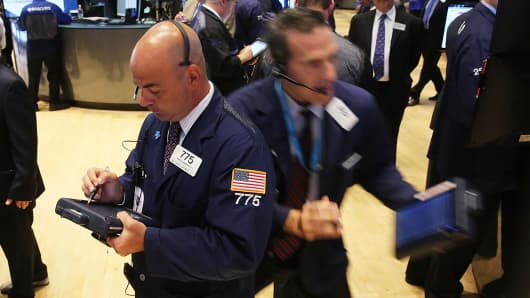U.S. stocks attempted a bounce for a second consecutive day on Thursday, amid continued signs of strength in the U.S. economy, following the recent plunge in global markets that sent the major averages into correction territory.
The major averages traded nearly 2 percent higher or more. The Nasdaq Composite swung out of correction and into positive territory for 2015. The Dow Jones industrial average traded about 300 points higher in an attempt to rise out of correction mode.
The S&P 500 rose out of correction with Wednesday's stellar gains of about 4 percent. As of late-morning trade, no components of the index had set new 52-week highs or lows.
Apple jumped more than 2 percent but remains in correction territory. The stock closed out of a bear market on Wednesday.
"Obviously the rally is continuing this morning. It's basically strength here after the good economic news we got," said Peter Cardillo, chief market economist at Rockwell Global Capital. He said stocks have likely hit a bottom. "The China concerns are about to subside as the market concentrates on the (U.S.) economic data."
"I thought it was a very pretty number, particularly the revisions," said Marie Schofield, chief economist and senior portfolio manager at Columbia Threadneedle Investments. "The principle areas where we saw those revisions (such as final sales) were important, gives the underlying trend in demand and growth."
However, she said with the increased trade deficit and buildup in inventories she is "not as encouraged by the second half as the second quarter."
Weekly jobless claims came in slightly lower than expected at 271,000, marking the
first decline in five weeks and indicating continued improvement in the labor market.
July pending home sales rose 0.5 percent, holding steady from an upwardly revised June reading of a 0.5 percent increase.
Bond yields trimmed gains, with the
10-year at 2.18 percent and the 2-year at 0.70 percent. Earlier, the
10-year yield hit 2.2 percent, its highest level since Aug. 19.
The U.S. dollar traded mixed, weaker against emerging market currencies and stronger against the euro and yen. The euro traded near $1.12 and the yen held around 120.5 yen against the greenback.
Crude oil is in focus after topping $40 a barrel in early trade. Crude oil futures for October delivery jumped $1.63 to $40.24 a barrel on the New York Mercantile Exchange as of 10:05 a.m.
Gold futures for December delivery fell $6.10 to $1,118.50 an ounce in morning trade.
"The combination of stronger economic data from both the U.S. and Europe and more stable China and EM, combined with a somewhat more dovish Fed postponing rate hikes is definitely good news for both the U.S. and Europe," said Ilya Feygin, senior strategist at WallachBeth Capital.
"The U.S. market has already partially reacted yesterday and will open about 0.8 percent higher this morning," he said. It faces overhead resistance less than 1 percent above here and buying on the elevated opening gap has not been a good tactical buy point in this more volatile market with lower liquidity."
The major averages had their best day in four years on Wednesday. After five consecutive days of triple-digit declines, the Dow surged 619 points into Wednesday's close, finishing the day at 16,285. The S&P 500 was up nearly 73 at 1,940.5. The Nasdaq surged more than 4 percent to 4,697.
The gains supported global markets on Thursday, with the DAX and STOXX Europe 600 both surging more than 3 percent in intraday trade and China's
Shanghai Composite index closing up 5.4 percent to reclaim the critical 3,000 mark. The Nikkei and Hang Seng closed up 1.08 and 3.60 percent, respectively.
The positive close in China was the first in five trading sessions, after improved sentiment in the U.S. managed to outweigh the fears surrounding China's slowing economy, which has been partly responsible for the recent selloff seen in global stocks.
As of the U.S. close on Wednesday, losses on the S&P Global BMI totaled $3.45 trillion, according to Howard Silverblatt of S&P Dow Jones Indices.
.530x298.jpg?v=1372338103)







